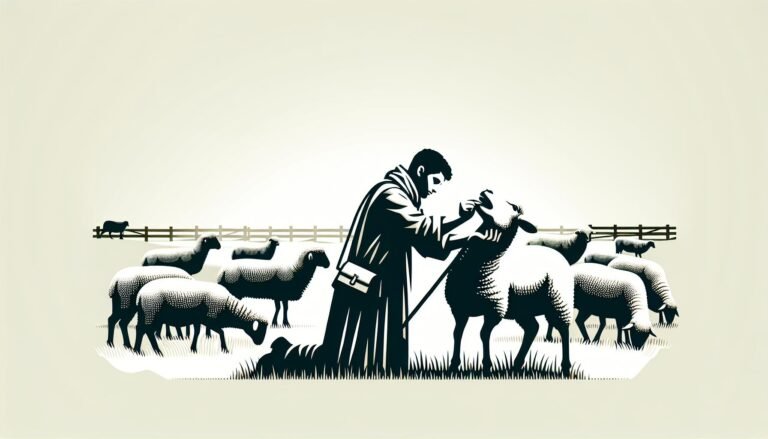Mastering the Art of Taming Sheep: A Step-by-step Guide for Success
Ever wondered how to tame a sheep? It’s not as complicated as it might seem. With the right approach and a dash of patience, you’ll have your woolly friend following your lead in no time.
First, it’s important to understand sheep behavior. These creatures are naturally cautious, preferring to stay within their flock for safety. That’s not to say they can’t be tamed, though. With a careful and consistent approach, you can earn their trust.
Next, let’s talk about the tools you’ll need. Don’t worry, there’s no fancy equipment involved. All it takes is a little time, a quiet demeanor, and a handful of tasty treats. Stick with me, and I’ll guide you through the process step by step.
Key Takeaways
- Understanding sheep behavior is crucial to taming them. They rely on the group for safety and survival and use body language for communication. Respect their flight zone to earn their trust.
- Sheep have excellent memory skills. They can remember the faces of at least 50 individual sheep and humans for more than two years, which can be used to your advantage when taming them.
- Building trust with the sheep is essential in this process, and this requires consistency, regular interaction, and rewards for good behavior.
- Patience plays a pivotal role in building a bond with the sheep. Regular, gentle interactions and respecting their body language and flight zone are critical to earning their trust.
- The key tools required to tame sheep include food treats, a Shepherd’s Crook for safe handling of the sheep, a herding dog to assist in controlling and guiding the sheep, and safety gear.
- The step-by-step process to tame sheep includes establishing a routine, understanding their body language, respecting their flight zone, learning to use a Shepherd’s Crook, using food treats as rewards, being consistent and patient, and involving a well-trained herding dog once the sheep have grown accustomed to your presence.
Understanding Sheep Behavior
Diving into the intricacies of sheep behavior is the first critical step in taming them. Sheep are herd animals, and they rely on the collective group for their safety and survival. They aren’t inclined to stick out or cause a ruckus. On the contrary, they are calm and prefer consistency in their daily routines.
Sheep possess a higher social nature, which means they communicate with one another using various methods. Body language plays an enormous part in this. If you’re keen, you’ll notice head movements, ear positions, tail wags, and even bleating patterns. Understanding these subtle cues can give you insights into what your sheep feels at any given moment.
Arguably, one of the most pertinent behaviors is the flight zone. It’s an invisible buffer of personal space that sheep have. Try not to violate this zone any time you’re trying to tame your sheep. It’s critical to respect their personal boundaries, especially when you first start working with them.
Here’s a little-known fact: Sheep have excellent memories. According to a study by researchers from the University of Cambridge, sheep can remember the faces of at least 50 individual sheep and humans for more than two years!
| Study By | Fact Discovered |
|---|---|
| University of Cambridge | Sheep can remember the faces of at least 50 individual sheep and humans for more than two years |
This extraordinary ability is a boon for those wanting to tame sheep. Once you’ve earned their trust and they recognize you, they’re more likely to let their guard down and be more accepting.
So there you have it — a glimpse into the unique and intricate world of sheep behavior. Armed with these insights, hopefully, you’re now ready to begin the journey of taming your sheep. Don’t forget, it’s all about building trust, respect, and consistency. So take your time and move at a pace comfortable for both you and your wooly friend.
Building Trust with Sheep
When it comes to establishing a bond with these woolly creatures, trust is paramount. And trust, as they say, isn’t built in a day. This is even truer when recent research tells us that sheep have excellent recall abilities. Yes, these unassuming animals can remember faces of up to 50 individual sheep and humans for over two years. Getting a sheep to trust you is tapping into this remarkable ability.
Winning a sheep’s trust might take time, but it’s worth every minute. Here’s a quick rundown of the key steps:
- Start Slow and Steady: Making sudden moves or loud noises can startle them. It’s better to keep calm and move slowly. This gives the sheep time to get used to your presence without feeling threatened.
- Regular Interaction: The way to a sheep’s trust is through interaction. Regularly spending time with them can familiarize you in their world. But again, patience is key.
- Consistency: Consistency plays a vital role in building trust. Keeping your interactions positive and similar builds a comfort level for the sheep. It’s easier for them to trust when they know what to expect from you.
- Rewards: Who doesn’t love a treat? A small reward for good behavior can go a long way in creating a positive correlation in the mind of your woolly friend.
Understanding their body language and reacting accordingly is critical in strengthening your connection with them. Take into account the flight zone. This is the distance at which a sheep will begin to feel threatened and back away. Respecting this personal sheep space illustrates that you are not a threat.
Building a relationship with sheep can even be therapeutic. They’re gentle, generally calm animals who respond well to calmness, kindness, and trust. The process of taming them provides an opportunity not only for us to understand them better but also to explore our own patience, understanding, and compassion.
Patience is Key
When it comes to building trust with our wooly friends, patience is indeed the key. Much like any other relationship, creating a bond with a sheep won’t happen overnight. It’s a gradual process and calls for a consistent approach.
Firstly, regular interactions are key. Don’t expect a sheep to warm up to you instantly. It’s not about how much time you spend in one go, rather it’s the frequency that matters. Regularly spend a small amount of time with them. Go slow and steady. Make sure you’re gentle and calm during each of these interactions. Aggressiveness or impatience will undo any progress made.
Learning about a sheep’s body language is another crucial step in this journey. After all, understanding sheep communication can help comprehend their comfort levels. Sheep get startled easily and will maintain a significant distance – referred to as the ‘flight zone’. This flight zone varies among sheep and it’s a clear indicator of their level of comfort with you.
Reward good behavior. This can be a game-changer in the road to building trust. An occasional treat can earn you some serious brownie points.
Let’s take a quick look at the summarized action steps:
- Regular and gentle interactions
- Understanding body language and respecting the flight zone
- Rewarding good behavior regularly
Building a trusting relationship with sheep, like any good thing in life, takes time. It requires consistency, patience and understanding. The therapeutic benefits that lie at the end of this road offer a source of comfort, a softer perspective on life, and a chance of personal growth. Remember, in the journey of taming a sheep, every little patient step matters.
Tools You’ll Need
Transitioning from a strategy to practical application, it’s time to discuss the essential tools you’ll need in your journey of successfully taming sheep.
Food Treats
The first essential tool in your kit should be food treats. Sheep are by nature, grazing animals, and can be easily influenced by their stomachs. These creatures love their food. A variety of food treats from apples, carrots to high-quality sheep feed may work wonders in influencing their behavior in a positive direction. It’s important to remember; treats must be healthy and suitable for a sheep’s diet.
Shepherd’s Crook
Second, you’ll need a Shepherd’s Crook. This tool isn’t just for style or a traditional symbol. It’s mechanical in function and plays a key role in handling sheep safely and effectively. The curve at the end of the crook helps to capture sheep without causing harm or fear, making it a critical tool in maintaining trust.
Herding Dog
Another important asset when taming sheep can be a herding dog. This isn’t strictly a “tool,” but rather a companion that can greatly assist in controlling and guiding sheep. Skilled dogs like Border Collies or Australian shepherds have a natural instinct to herd and can streamline the process of taming sheep significantly.
Safety Gear
Last but not least, don’t forget your safety gear. Sheep are generally gentle animals, but in moments of fear or stress, they can become unpredictable. Sturdy boots and gloves might seem small, but these are non-negotiable components of your gear that can help prevent any potential injuries.
Remember, it’s not just about possessing these tools; it’s about learning how to use them effectively. With time and practice, you’ll be well on your way to becoming an expert in taming sheep. As we move forward in this endeavor, the foundation of trust and patience will still be our guiding principles. With these tools and the principles in mind, let’s explore and learn more about specific strategies of taming sheep.
Step-by-Step Process
First, let’s establish routine and familiarity. It’s crucial to ensure your presence doesn’t cause sheep’s flight response because it’s a sign they feel threatened. Because they’re prey animals, they’ll naturally want to run away when they sense danger. Stick to a regular feeding and interaction schedule so they begin recognizing and trusting you.
Next up, understand the sheep’s body language. Recognizing signs of stress or discomfort is key to forming a harmony between you and your flock. For example, when their ears are erect, they’re alert and possibly nervous. However, if their ears are relaxed, they’re calm.
Another important step is to respect their flight zone. This is an invisible bubble around the sheep that, when invaded, causes the sheep to move away. Over time, by respecting their flight zone, it will gradually decrease leading to a close bond.
It’s time for the tools. Learn how to use a Shepherd’s Crook effectively. This long staff is not for harm, but merely for direction, used to guide the sheep where you want them to go.
Do not forget the rewards! Sheep are motivated by treats, so use food rewards to your advantage.
One of the most important tools in taming sheep is time, so be consistent and patient. Don’t expect immediate results but rest assured, your persistence will pay off.
Lastly, bring your herding dog into the fold once sheep have adapted to your presence. A well-trained dog is an invaluable ally in controlling and comforting your flock.
Isn’t just about taming sheep—it’s a soothing, rewarding pursuit that demands dedication and takes understanding and mutual respect to a whole new level!
Below, I’ve listed the summarized steps in a brief, memorable format:
- Establish routine and familiarity
- Understand the sheep’s body language
- Respect their flight zone
- Learn to use a Shepherd’s Crook
- Use food rewards
- Be consistent and patient
- Involve your herding dog
Remember, these steps should be practiced regularly, and with patience. You’ll soon discover the incredible bond you can form with these charming animals.
Conclusion
So there you have it. Taming a sheep isn’t a task to be taken lightly. It’s a journey that requires patience, understanding, and the right tools. But when done right, it’s a rewarding experience that can lead to personal growth and a unique bond with these wonderful creatures. Remember, it’s all about building trust through gentle interactions and respecting their space. The Shepherd’s Crook, food treats, and a herding dog can be your best allies. But they’re only as good as your ability to use them effectively. So take the time to learn, be consistent, and stay patient. The road to taming a sheep may be long, but the rewards are well worth it. Happy taming!







